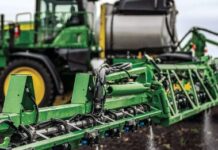Plant hardy bulbs now to add spring color
Tulips, daffodils and more should go in the ground by early November
MANHATTAN, Kan. – For gardeners who think of their yard as a canvas, Kansas State University horticulture expert Ward Upham says now is a good time to build the color palette.
Upham said gardeners can plant hardy bulbs in October through early November as long as the soil temperature remains above 40 degrees F, which allows them to develop roots.
Some of the popular, colorful examples: tulips, daffodils, grape hyacinths and crocuses.
“Although many of the best bulbs have probably already been purchased, garden centers may still have a good selection,” Upham said. “Be sure to select large, firm bulbs that have not begun to sprout.”
While many bulbs can adapt to a wide range of soil types, none can tolerate poorly-drained soil, he added. “Prepare the planting bed by adding organic matter, such as peat moss, well-rotted manure or compost, and mix that into the soil.”
Before planting, Upham recommends having a soil test done to determine the nutrients needed.
“Garden soils that have been fertilized regularly in the past may have excess levels of phosphorus, which can interfere with the uptake of other essential micronutrients,” he said.
Upham and his colleagues in K-State’s Department of Horticulture and Natural Resources publish a weekly horticulture newsletter in which they cover guidelines for many yard- and garden-related chores.
The Oct. 19 newsletter covers recommendations for fertilizing planting beds, including mixtures that would help to offset high phosphorus levels. In some cases, even common lawn fertilizers can work as long as they don’t contain weed preventer or weed killer.
Some sources of organic fertilizers include blood meal, cottonseed meal and soybean meal.
“If you have not taken a soil test, or if phosphorus is needed, add a low analysis, balanced fertilizer such as 5-10-5 or 6-10-4 at the rate of three pounds per 100 square feet,” Upham said.
In general, hardy bulbs should be planted at a depth two to three times their size, but Upham urges gardeners to check the planting instructions specific to each type of flower.
In addition to K-State’s weekly horticulture newsletter, interested persons can also send their garden- and yard-related questions to Upham at [email protected], or contact your local K-State Research and Extension office.
# # #
Sidebar
Clean up the garden
Fall is traditionally a time for cleaning up gardens.
“Normally we recommend clear-cutting dead stems to help control insect and disease problems,” said Kansas State University horticulture expert Ward Upham. “With herbaceous perennials that have been pest-free, you might want to consider leaving some to provide structure, form and color to the winter garden.”
For example, he said, ornamental grasses can be attractive in the winter, though they can be a fire hazard near structures. The same goes for evergreen and semi-evergreen perennials.
“Of course, some perennials are naturally messy after dormancy and should be cut back in the fall,” Upham said.
Foliage left on marginally hardy plants, such as tender ferns, can help ensure overwintering of the plant’s crowns. Seed heads on some perennial plants also can provide seeds for birds.
-30-
FOR PRINT PUBLICATIONS: Links used in this story
K-State Horticulture Newsletter, https://hnr.k-state.edu/extension/info-center/newsletters/index.html
K-State Research and Extension local offices, www.ksre.k-state.edu/about/stateandareamaps.html
K‑State Research and Extension is a short name for the Kansas State University Agricultural Experiment Station and Cooperative Extension Service, a program designed to generate and distribute useful knowledge for the well‑being of Kansans. Supported by county, state, federal and private funds, the program has county extension offices, experiment fields, area extension offices and regional research centers statewide. Its headquarters is on the K‑State campus in Manhattan. For more information, visit www.ksre.ksu.edu. K-State Research and Extension is an equal opportunity provider and employer.
Story by:
Pat Melgares
785-532-1160
For more information:
Ward Upham
785-532-6173




